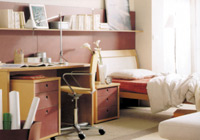Furniture
5. Bedroom furniture and fitments
|
Both fitted and free standing wardrobes and storage units in bedrooms often feature doors, drawer fronts and tops manufactured from MDF. |
|
As an alternative to recess moulding, a raised surface effect can be created by bonding MDF shapes or profiled MDF mouldings to the fronts of doors and drawer fronts using polyvinyl acetate adhesive, hot melt or double sided adhesive tape. Standard or veneer wrapped MDF mouldings can be fixed as a cornice along the tops of a run of units or used to finish off the joints between the units and adjacent walls.
The ease of cutting curves and other interesting shapes in MDF provides scope for creating special effects in fitted bedrooms. Shaped pelmets can be fitted over the bed to complement shaped headboards and bed ends. Although most fitted bedrooms have white or light colour paint finishes, the possibilities of novel design effects that can be achieved with ragging, marbling or other textured finishes should not be overlooked.














